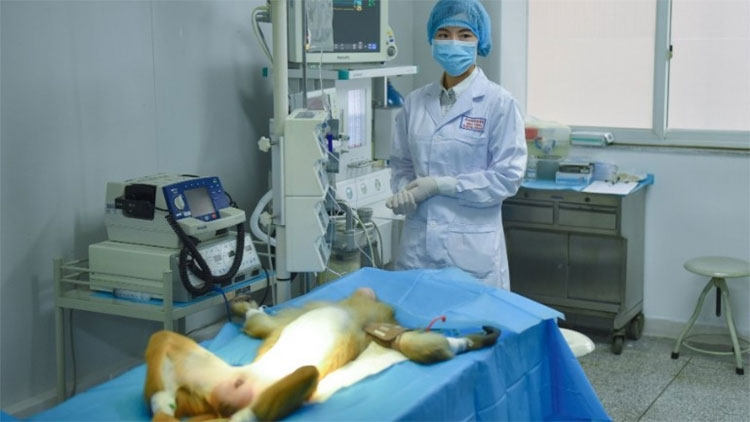China successfully implanted 3D blood vessels into monkeys
The breakthrough development of 3D printing technology in medicine can bring hope to nearly 1.8 billion heart patients.
According to CNN, Chinese scientists working for Sichuan Revotek Company have successfully printed 3D blood vessels and transplanted the body of the brown monkey (monkey rezut) . This is a big step on the path to mass printing of human body parts for transplantation.
Sichuan Revotek is "the first company to maintain cell viability with 3D printing technology" , said James Kang, chief scientist and CEO of Sichuan Revotek.
The key to success is the biological material developed by Sichuan Revotek, called bio-ink , made from stem cells derived from the fatty tissue of monkeys.

Chinese company implanted 3D blood vessels into 30 brown monkeys.
Stem cells are capable of developing into any cell in the body, and the use of monkey stem cells themselves means that blood vessels will not be rejected by the immune system when implanted.
Patented with the name "Biosynsphere" . Bio-ink consists of stem cells living in a micro-environment, full of growth factors and nutrients that can stimulate cells to grow into the types of cells needed to form a circuit blood works.
The use of stem cells from adipose tissue is also safer than other conventional sources - such as embryos, Kang said.
During the surgery, the team of scientists replaced a 2cm long abdominal artery with 3D printed blood vessels in 30 brown monkeys.
Within 5 days after transplantation, stem cells were able to develop into different types of cells needed to form a normal biological blood vessel, including endothelial cells and smooth muscle cells. .
A month later, the grafted vessels had completely entered the monkey's own arteries and had the "identical" function as the original blood vessels of monkeys. Grafting circuits have been shown to support vascular function, such as supporting blood flow and transporting nutrients throughout the body, because bio-ink helps them to fully develop into vascular vessels.
Experts agree that the success of testing is a breakthrough.
"This is an important breakthrough in the health sector," said Alex Lee, an adjunct professor at the Chinese University of Hong Kong. Lee's team used 3D printing technology to create heart prototypes, applied in heart surgeries.
However, Ms. Lee said it still took years to observe the long-term effects of grafting circuits and be cautious, as they "may be blocked again after years".
Kang said his company is seeking permission from the government to test the process with people.
Last year, Sichuan Revotek created the world's first 3D printed blood vessel, thought to be able to produce living tissues and organs. Suchuan Revotek is one of the technology startups in China creative center, in Chengdu, Sichuan.

Scientists hope that one day, the technique of transplanting human body parts created by 3D printing technology will be applied to humans.
3D printing of human body parts: long journey
In 2016, we witnessed a "boom" producing 3D biological structures. Russian scientists have implanted a 3D thyroid gland into a lab rat and expect to do the same for humans in 15 years. And L'Oreal, the famous French cosmetics company, claims to be developing 3D skin tissue for testing. A startup in New York is EpiBone, trying to apply 3D printing in custom bone grafting.
However, these advances are raising moral worries, analysts say they could raise a big debate, leading to technology-tight policies.
Ms. Lee found that 3D printed blood vessels were a real opportunity for people and hoped to "be tested in a few years". She predicted that other body parts could become true.
Parts of the human heart, such as heart valves, have more complex shapes and tissue structures, so it will be a technological challenge to 3D printing.
The printing of living agencies, like the whole heart, still has "a long way ahead" , Ms. Lee said.
- Austria successfully tested artificial blood vessels on mice
- Medical breakthrough: culture of blood vessel walls
- Apple develops device that predicts heart attack by listening to blood vessels?
- 3D blood vessels
- Blood vessels cultured from skin cells
- Successful transplantation of retinal cells from iPS in monkeys
- Green light helps thicken artificial blood vessels
- Monkeys near the Fukushima plant may be contaminated
- The new 'glued' glue is weakened by blood vessels
- The first glowing monkeys in the world
- Generates blood vessels from stem cells
- China: successfully implanted spinal disc
 Green tea cleans teeth better than mouthwash?
Green tea cleans teeth better than mouthwash? Death kiss: This is why you should not let anyone kiss your baby's lips
Death kiss: This is why you should not let anyone kiss your baby's lips What is salmonellosis?
What is salmonellosis? Caution should be exercised when using aloe vera through eating and drinking
Caution should be exercised when using aloe vera through eating and drinking